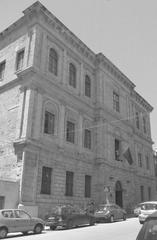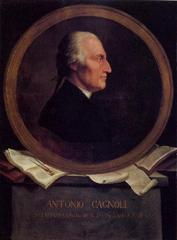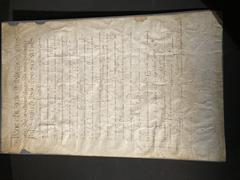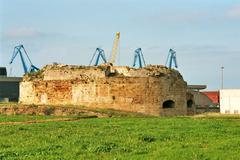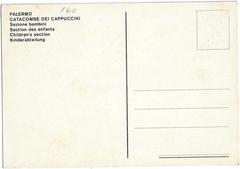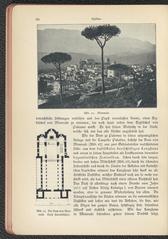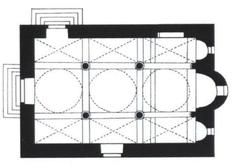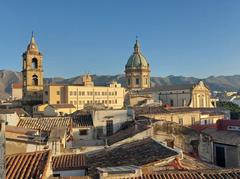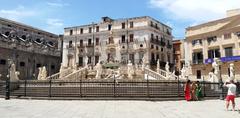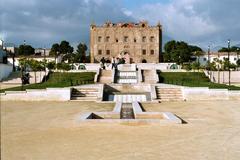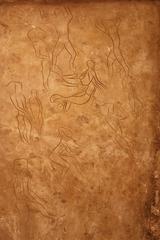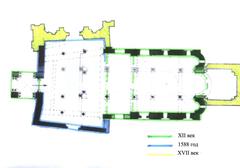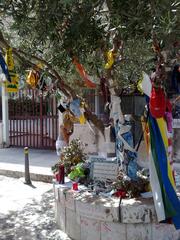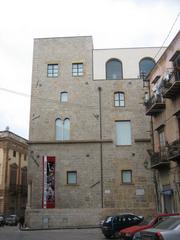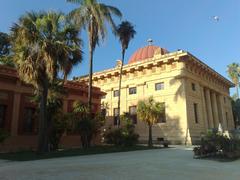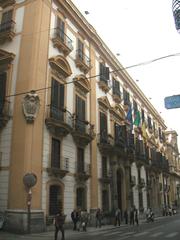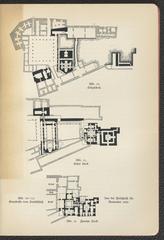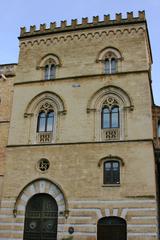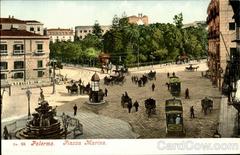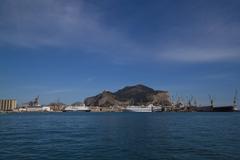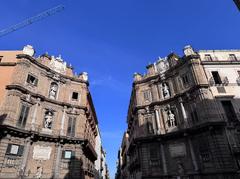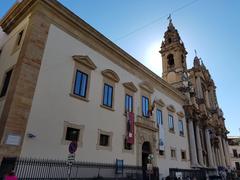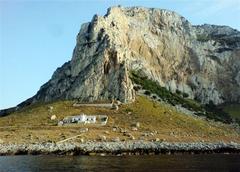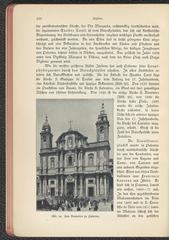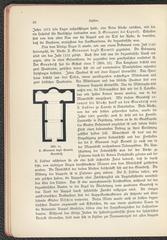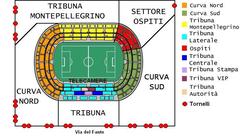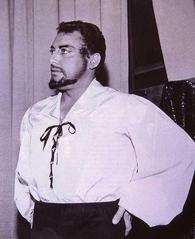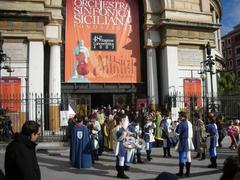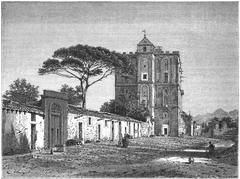Kursaal Biondo Palermo: Visiting Hours, Tickets, and Comprehensive Guide to Historical Sites
Date: 14/06/2025
Introduction
Nestled in the heart of Palermo, Italy, the Kursaal Biondo is a striking embodiment of the city’s rich cultural and architectural heritage. Originally inaugurated on September 19, 1914, this historic landmark was designed by Ernesto Basile, a master of the Liberty Style—Italy’s interpretation of Art Nouveau. Conceived by the entrepreneurial Biondo brothers, the complex was envisioned as a grand multi-purpose entertainment venue, combining theater, cinema, gardens, cafés, and social spaces to reflect Palermo’s cosmopolitan aspirations in the early 20th century (Google Arts & Culture; CulturalHeritageOnline).
Today, the Kursaal Biondo—now the prestigious Teatro Biondo—continues to serve as a dynamic center for the performing arts, hosting renowned theatrical seasons, festivals, and cultural events. This guide provides everything you need to know for visiting, including history, architectural highlights, ticketing information, accessibility, nearby attractions, travel tips, and answers to frequently asked questions.
Table of Contents
- Introduction
- Historical Overview and Founding Vision
- Architectural Significance
- Cultural Role in Palermo’s Belle Époque
- Evolution and Adaptation Over Time
- Visiting Information
- FAQ
- Conclusion
- References
Historical Overview and Founding Vision
The Kursaal Biondo was born from the vision of the Biondo brothers—Andrea, Eugenio, and Luigi—who sought to establish a venue that would rival Europe’s finest leisure establishments. Their ambition was to foster both high culture and popular entertainment, making the Kursaal Biondo a beacon for Palermo’s Belle Époque society (Google Arts & Culture).
Commissioned to Ernesto Basile, a leading advocate of the Liberty Style, the complex was designed to offer cinema, theater, gardens, social lounges, and open-air spaces, thereby providing Palermo’s citizens and visitors with a vibrant cultural hub.
Architectural Significance
Liberty Style and Basile’s Design
Basile’s architectural mastery is reflected in the Kursaal Biondo’s harmonious blend of reinforced concrete, steel, and decorative arts. The façade features elegant, undulating lines, floral motifs, wrought iron balconies, and polychrome ceramic tiles—hallmarks of Art Nouveau that set the building apart from the city’s predominantly Baroque and Neoclassical architecture (art.nouveau.world).
A highlight of the entrance is the presence of two sculpted female figures—Allegories of Dance—created by Archimede Campini, symbolizing the building’s dedication to the performing arts. The entrance hall is adorned with teal glass tiles and a frieze of polychrome tiles, further emphasizing the Liberty aesthetic (Google Arts & Culture).
Multifunctional Complex
Originally, the Kursaal Biondo spanned over 4,500 square meters and integrated a cinema-theater, restaurant, café, billiard room, garden, and outdoor concert portico. This multifunctional approach made it a lively center for both socializing and cultural events (CulturalHeritageOnline).
Cultural Role in Palermo’s Belle Époque
During the early 20th century, Palermo flourished as a cosmopolitan city. The Kursaal Biondo played a pivotal role in this urban and cultural transformation, serving as a gathering place for intellectuals, artists, and the broader public. The complex’s innovative design and diverse programming fostered an atmosphere of creative exchange and social inclusivity (Google Arts & Culture).
Its central location and Liberty Style architecture reflected the city’s embrace of modernity while maintaining a distinct Sicilian character, contributing to Palermo’s unique urban landscape.
Evolution and Adaptation Over Time
The Kursaal Biondo has demonstrated remarkable adaptability. Initially combining cinema and theater, it shifted focus towards live theatrical performances as cultural trends evolved, eventually becoming the permanent Teatro Biondo. During challenging periods, such as the popularity surge of cinema and the aftermath of World War I, the venue adapted by hosting film screenings and community events (palermoviva.it).
In 1966, Margherita Biondo bequeathed the theater to the city, reinforcing its mission as a cultural space open to all citizens. Restoration efforts have preserved its architectural integrity, and today, it stands as one of Italy’s “teatri stabili,” nurturing theatrical innovation and emerging talent (teatrobiondo.it).
Visiting Information
Visiting Hours
- Standard Hours: Tuesday to Friday: 10:00 AM – 7:00 PM
Saturday and Sunday: 10:00 AM – 8:00 PM
Monday: Closed - Box Office: Open Monday to Saturday 9:00–13:00 and 15:00–19:00 (summer); adjusted hours outside high season. Also open one hour before performances.
Visiting hours may vary for special events and holidays. Always check the official website beforehand.
Tickets and Pricing
- Ticket Range: €10–€40 per event, with discounts for students, seniors, and groups.
- Purchase Options:
- Online via the Teatro Biondo official website
- At the box office (Via Vittorio Emanuele, 365, Palermo)
Accessibility
Teatro Biondo is committed to accessibility, offering:
- Wheelchair access and adapted restrooms
- Assistance for visitors with disabilities (contact in advance)
Travel Tips
- Location: Centrally situated in Palermo’s historic district; accessible by foot, bus (Via Maqueda and Via Vittorio Emanuele), or taxi.
- Parking: Limited in the historic center; use public transit or nearby paid lots.
- Best Time to Visit: Weekdays or during special events for a richer experience.
Nearby Attractions
Enhance your visit with nearby highlights:
- Teatro Massimo: Italy’s largest opera house
- Palermo Cathedral: A fusion of Norman, Gothic, and Baroque styles
- Quattro Canti: Iconic Baroque crossroads
- Historic Markets: Ballarò and Vucciria
Special Events and Guided Tours
The theater hosts renowned performances, festivals, and educational workshops year-round. Guided tours, focusing on architectural and historical features, are available by appointment—check the official site for details.
Photographic Opportunities
- The Liberty-style façade, with its Allegories of Dance sculptures
- The ornate entrance hall and teal glass tiles
- The atmospheric interiors and adjoining portico
Photography is generally allowed in public areas but restricted during performances.
FAQ
What are Kursaal Biondo visiting hours?
Tuesday to Sunday, 10:00 AM–7:00/8:00 PM. Closed Mondays. Details vary—verify on the official website.
How can I buy tickets?
Purchase online at the Teatro Biondo website or at the box office.
Is the theater accessible for wheelchair users?
Yes. Wheelchair access and adapted facilities are available. Notify staff for assistance.
Are guided tours available?
Yes, often by reservation. Check the official site for tour schedules.
Are performances in English?
Most are in Italian; some offer English surtitles or programs.
Conclusion
The Kursaal Biondo is more than a historic theater—it is a vibrant cultural landmark at the heart of Palermo’s artistic scene. From its Liberty-style architecture to its contemporary programming, it offers a memorable experience for history enthusiasts, architecture aficionados, and performing arts lovers. Its central location, accessible facilities, and diverse events make it an essential part of any Palermo itinerary.
Plan your visit by checking current hours and events, purchasing tickets in advance, and exploring nearby historical sites for a comprehensive cultural adventure. For the latest updates, download the Audiala mobile app and follow Teatro Biondo on social media.
References
- Google Arts & Culture: Kursaal Biondo and Palermo’s Belle Époque
- CulturalHeritageOnline: Kursaal Biondo
- art.nouveau.world: Ex Kursaal Biondo
- Teatro.it: Teatro Biondo Programming
- Teatro Biondo Official Site
- palermoviva.it: Teatro Biondo History
- Palermo Culture Events
